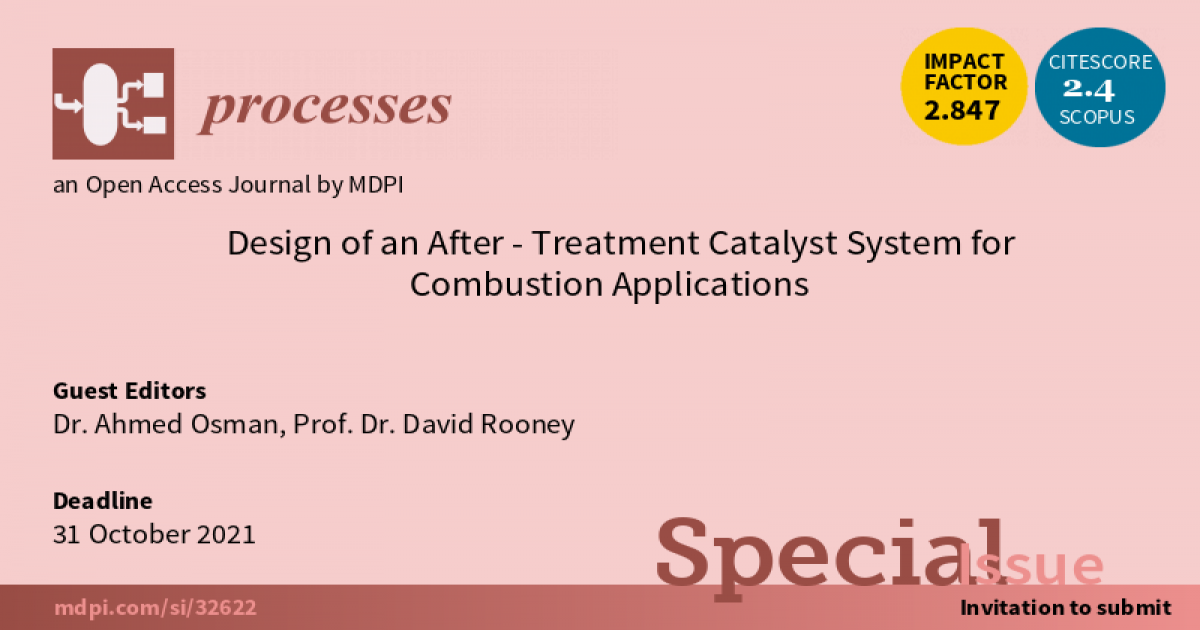Design of an After-Treatment Catalyst System for Combustion Applications
A special issue of Processes (ISSN 2227-9717). This special issue belongs to the section "Catalysis Enhanced Processes".
Deadline for manuscript submissions: closed (31 October 2021) | Viewed by 15437

Special Issue Editors
Interests: heterogenous catalysis; methane oxidation; methanol synthesis; hydrogen production; biomass; plastics
Special Issues, Collections and Topics in MDPI journals
Interests: heterogeneous catalysis, engineering of ionic liquid processes and rhermophysical property prediction; energy capture and storage; anaerobic digestion gas processing
Special Issue Information
Dear Colleagues,
This Special Issue on “Design of an After-Treatment Catalyst System for Combustion Applications” is to promote the research and progress in the area of after-treatment catalyst systems by bringing together academic scientists and industry working in the catalysis and process engineering fields in developing robust and cheaper alternatives to the current catalytic combustion problem, either stationary systems such as boilers or mobile combustion systems such as vehicles. The Special Issue will be focusing on the catalyst materials development, characterisation and testing and in the design of the reactor and heat transfer system in after-treatment catalyst systems.
Basics
1. Preparation and utilisation of noble metal catalyst in combustion reactions;
2. Preparation and use of transition metal catalysts in combustion reactions;
3. Methane total and partial oxidation reactions;
4. Catalyst deactivation in combustion reactions;
5. Water gas shift reactions in combustion/reforming reactions;
6. Modelling and simulation for process optimisation.
Applications
1. Stationary combustion systems (boilers and CHP (combine heat power), etc.);
2. Photocatalytic systems in oxidation processes;
3. Application of combustion reaction in solid oxide fuel cells;
4. Mobile combustion systems (vehicles, etc.);
5. Thermal reactor design and application in combustion systems.
Dr. Ahmed Osman
Prof. David Rooney
Guest Editors
Manuscript Submission Information
Manuscripts should be submitted online at www.mdpi.com by registering and logging in to this website. Once you are registered, click here to go to the submission form. Manuscripts can be submitted until the deadline. All submissions that pass pre-check are peer-reviewed. Accepted papers will be published continuously in the journal (as soon as accepted) and will be listed together on the special issue website. Research articles, review articles as well as short communications are invited. For planned papers, a title and short abstract (about 100 words) can be sent to the Editorial Office for announcement on this website.
Submitted manuscripts should not have been published previously, nor be under consideration for publication elsewhere (except conference proceedings papers). All manuscripts are thoroughly refereed through a single-blind peer-review process. A guide for authors and other relevant information for submission of manuscripts is available on the Instructions for Authors page. Processes is an international peer-reviewed open access monthly journal published by MDPI.
Please visit the Instructions for Authors page before submitting a manuscript. The Article Processing Charge (APC) for publication in this open access journal is 2400 CHF (Swiss Francs). Submitted papers should be well formatted and use good English. Authors may use MDPI's English editing service prior to publication or during author revisions.
Keywords
- Combustion reaction
- Total methane oxidation
- Partial methane oxidation
- Nobel metal catalyst
- Catalysis
- Photocatalysis
- Modelling
- Deactivation
- Characterisation
- Oxidation
Benefits of Publishing in a Special Issue
- Ease of navigation: Grouping papers by topic helps scholars navigate broad scope journals more efficiently.
- Greater discoverability: Special Issues support the reach and impact of scientific research. Articles in Special Issues are more discoverable and cited more frequently.
- Expansion of research network: Special Issues facilitate connections among authors, fostering scientific collaborations.
- External promotion: Articles in Special Issues are often promoted through the journal's social media, increasing their visibility.
- e-Book format: Special Issues with more than 10 articles can be published as dedicated e-books, ensuring wide and rapid dissemination.
Further information on MDPI's Special Issue polices can be found here.






